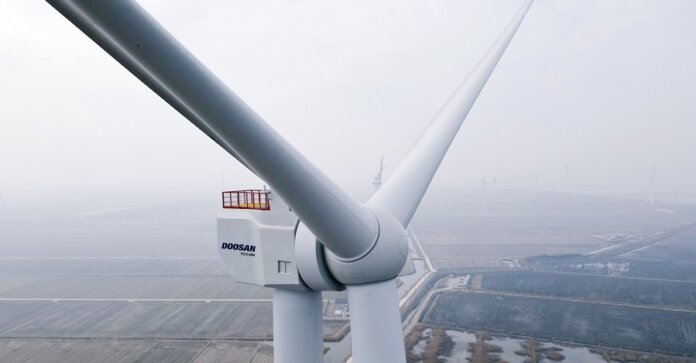Doosan Enerbility has obtained a type certification from DEWI-OCC, the Germany-based international certification authority, for its 8 MW offshore wind power system (Model DS205-8MW), making Doosan the first company in Korea to accomplish such a feat.
Since 2018, Doosan Enerbility has been pursuing the development of an 8 MW large-capacity offshore wind power system with the support of the Korea Institute of Energy Technology Evaluation and Planning (KETEP), which is under the Ministry of Trade, Industry and Energy. This past January, a prototype was implemented in Yeonggwang of South Jeolla Province, after which a demonstration run was carried out, followed by the securing of the international certification. The international certification received by Doosan is only awarded to those who have satisfied all the applicable criteria in the areas of design evaluation, manufacturing evaluation and type testing.
The DS205-8MW, the offshore wind turbine model with the largest capacity to date in Korea, was designed to be suitable for the Southwest Sea environment, which has notably lower wind speeds compared to Europe. The diameter of the rotor was lengthened to 205 meters (blade length: 100 meters), so that the wind turbine could be used even when the average wind speed is 6.5 m/s and thereby making it possible to record a utilization rate over 30%.
The 100 meters-long blade was developed jointly by Doosan Enerbility with the Korea Institute of Materials Science (KIMS) and the blade manufacturer Human Composites. At the Buan Wind Power Testing Facility, an internationally certified testing institute, the structural soundness and security of the blade were verified by conducting repeated fatigue load tests on the design lifecycle of 25 years and load testing under extreme conditions such as typhoons.
“We are seeking to expand the market by introducing the 8 MW offshore wind turbine, which was developed jointly by the local industry, academia and research sectors, to the Korean offshore wind power market which has been the stage of competition for global wind power companies,” says Hongook Park, CEO of Doosan Enerbility’s Power Services Business Group. “We aim to increase the local manufacturing of parts, which is currently over 70 percent to an ever higher rate, and to apply our local technology and manpower to the area of turbine maintenance services, which has largely been dependent on overseas companies until now. This will ultimately help to contribute to promoting the domestic offshore wind power ecosystem.”
Doosan Enerbility supervised the design, manufacturing and demonstration process. Human Composites Co. handled the blade manufacturing while KIMS was in charge of the blade testing and certification. Seil Engineering Co. was responsible for substructure design, transportation and installation. Seoul National University was in charge of the noise reduction for turbine blades.
Doosan Enerbility, which first commenced the wind power business in 2005, currently holds the 3.3 MW, 5.5 MW and 8 MW wind turbine models. The company is working to expand the wind power business, as reflected in the company building its second wind turbine shop last year to enable manufacturing of the 5.5 MW model, seeing to the preparations for setting up the 8 MW wind turbine shop, and restructuring the wind power organization to become larger and planning for development of next-generation, ultra-large models.




